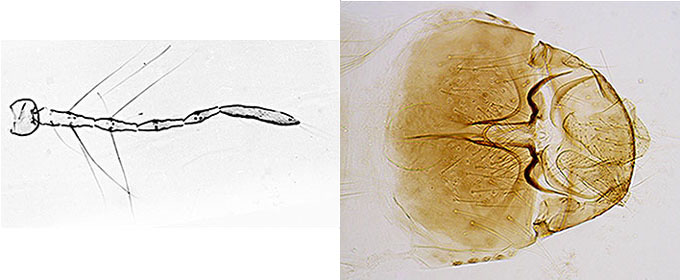Species 3e. Chironomus (Chaetolabis) ochreatus Townes, 1945.In BOLD Bin: BOLD:AAP5112 Adult: Wing length 3.9-4.6 mm, width 0.93-1.03 mm. VR about 0.93-0.96. Head yellowish green; antennae and palps dark. AR about 3.9-4.1. Frontal tubercles small, about 5-10 x 8 µm. Palps (micron): 80 : 72 : 277 : 304 : 420. About 30-45 clypeal setae. Thorax greenish, mesosternum and mesonotal vittae brownish yellow, posterior part of postnotum brown. Setae: Acrostichal - 12; Dorsocentral - 25-26; Prealar - 7; Scutellar, anterior (2 rows) 4+10; posterior 13 (total Scutellar 27). Legs yellowish green, anterior legs darkened at the knees, tibia and tarsi dark; other legs with tibiae yellow brown shading to black on distal tarsal segments. Anterior tarsus without a beard. Leg lengths (in microns) and proportions as below:  Male terminalia of C. (Chaetolabis) ochreatus. Note the club shaped superior volsella. Median mesoscutal vitta dark brown and divided longitudinally by a pale line. Otherwise similar to the male except for the usual sexual differences. Further data based on one reared specimen: Wing length 4.98 mm, width 1.40 mm. VR 0.90. 3-4 Scf on brachiolum, 23-26 setae on squamal fringe. Head: Antennal segments (micron)(fraction of neck in brackets): 230 (0.28): 160 (0.47): 175 (0.46): 135 (0.43): 295, segments not sufficiently swollen to give obvious necks (see figure below). AR 0.42, A5/A1 1.28. Frontal tubercles small, about 9-10 x 12.5 µm. Palpal proportions (microns): 75 : 60 : 293 : 333 : 426; P5/P4 1.28; P5/P3 1.45. Width of clypeus 1.9 times the diameter of the antennal paedicel; about 54 clypeal setae. Thoracic setae: Acrostichal - abt 13; Humeral 5 in a patch + 2 linear and 6 in a loose patch; Dorsolateral - 38-41 (Humeral + Dorsolateral 43-46); Prealar - 8-9; supraalar - 1; Scutellar, anterior row 14, posterior row 21 (total 35). Leg lengths (in microns) and proportions as below:
 Antenna (left) and ventral abdomen (right) of C. (Chaetolabis) ochreatus female. Pupa: Length of exuvia about 10.3 mm (male), inner margin of wing case about 2.04 mm; color yellowish brown; with well developed narrow cephalic tubercles (70 x 20 µm) arising from a broad base, with subapical seta about 56-58 µm long; also a large secondary tubercle or frontal wart about 56-68 µm long and 43-48 µm wide at the base. Fourth instar larva: In two of the Wisconsin sites there were two different sized larvae in samples taken in June: common large larvae and a single much smaller larva. Samples taken later in the summer contained only larvae of similar size. The obvious answer that they were 3rd instars was not acceptible as these smaller larver were able to be sexed, which is not possible for 3rd instar larvae. A number of characters indicate that these are C. ochreatus: thummi-type larva with pale head capsule, curvature of the basal antennal segment, long segment A2 and similar morphology of other head characers: Gula region and frontoclypeus usually pale, but some specimens have very slight darkening of both. Width of frontoclypeus between the antennal bases (ASA of Vallenduuk & Moller Pillot, 1997) about 186-190 µm, greater than the distance between the S4 setae (about 160-175 µm). Oesophageal opening about 83.5 µm wide and 3.7 times wider than deep. Mentum (Fig. d) with relatively pointed teeth; c1 tooth moderately broad with short parallel sides, c2 teeth moderately well seperated (type IB); 4th laterals hardly reduced (type I); 6th laterals arising at about the same level as other teeth. Ventromental plates (Fig. e) about 248-250 µm wide and 3.06-3.38 times wider than deep and 1.08-1.09 times the mentum width; separated by about one third of the mentum width (IPD); with about 39-45 striae (Webb et al. 1987). Premandible (Fig. b) with relatively sharp inner tooth, about 4-5 times wider than the narrow, sharp outer tooth (type B2). Pecten epipharyngis (Fig. c) with about 23.2 (21-25) irregular teeth, with small interstitial teeth (type D). Antenna (Fig. a) with A1 about 35-44% of the VHL; A2 long, over 1/3 length of A1, which itself is about 3.3-4.3 times longer than wide; ring organ a third to almost half way up from the base; AR 1.95 (1.50-2.27; antennal segment proportions (micron) 154 : 44 : 11 : 18 : 8. i.e. A5 about same length as A3. Mandible (Fig. f) with 3rd inner tooth partly separated but only moderately pigmented (type IIB); with about 19 (17-21) furrows on outer surface at base; Pecten mandibularis of 13.2 (12-15) taeniae; Mdt-Mat about 28, MTR 0.31-0.47. Cytology: 3 polytene chromosomes which may have the modified thummi arm combination, AB, CD, GEF; but Keyl pattern very difficult to recognize. Found: Ontario – Cambridge (43.40°N, -80.30°W) (Telfer et al. 2015) At depth of about 4 m amongst Drepandocladus exannulatus, and in pools. Wiederholm (1979) considered Ch. ochreatus to be a synonym of Ch. atroviridis, but did note that this was subject to confirmation by further analysis. The presence of the large secondary tubercles in the pupa (above) shows that it is clearly distinct. Detailed features of the larval ventromental plates are given by Webb et al. (1987). DNA analysis: Sequence for the mitochondrial CO1 and the nuclear gb2β genes are available. |
Modified: 14 July 2025
Access: Unrestricted
Copyright © 2000-2025, Jon Martin.